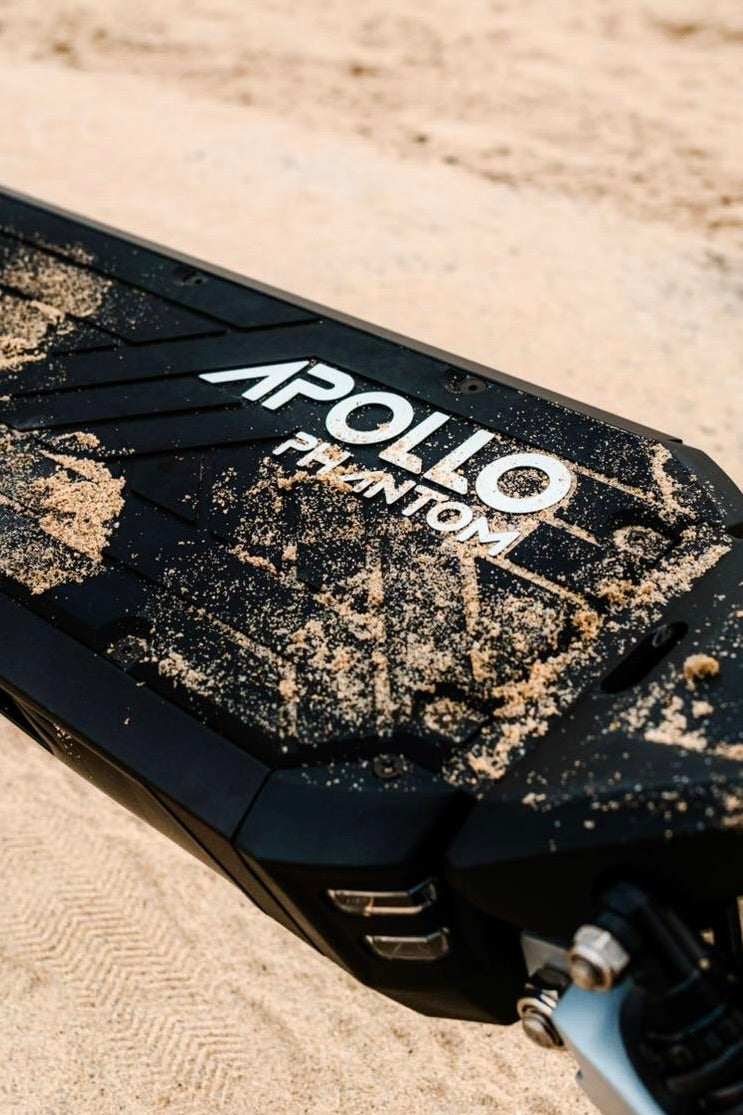If you ever have an idea to take your e-scooter to the desert/beach to make believe you’re Paul Atreides riding the worm, hold your horses (or in this case your worm). Sand is not your friend, especially if you care about the longevity of your electric scooter. While some e-scooters are designed for off-road use and can handle challenging terrain like gravel trails and unpaved bike paths, riding on sand is not advised. So, get off that worm and read on to see why.
Are electric scooters designed for sand?
Let’s make this clear. Nothing can stop you from riding your e-scooter on sand, after all it’s yours. While it may seem like a thrilling perspective to ride along the coastline, let us tell you why you shouldn’t.
In most cases, if you give it a go once or twice, there’s a good chance nothing detrimental will happen to it. In the end, Apollo scooters have an IP rating of 66, meaning both water and dust have a hard time entering the bearings or motor, as they’re sealed airtight.
But, a prolonged exposure to tiny sand particles and salty water could potentially corrode the frame and eventually damage the electrical components. So, it’s up to you whether you want to take those risks or not. So, be warned, you may shorten the lifespan of your electric scooter and incur a high repair cost.
A word to the wise
Even if you ignore the potential risks and decide to ride on sand anyways; there are a couple of things you still need to remember about to stay safe and minimize damage to your electric scooter.
Reduce tire pressure
Slightly lowering your tire pressure increases the tire's contact area with the sand, providing better traction and stability. Aim for around 20-25 PSI, but be sure to re-inflate afterward for regular use.
Choose hard-packed sand
Whenever possible, opt for areas with hard-packed sand. Soft, loose sand will be more difficult to navigate and cause more wear and tear.
Slow and controlled
Unlike paved roads, sand demands a steady pace and gentle movements. Adjust the scooter's speed, avoid sharp turns and brake gradually, as your front wheel may sink and catapult you to the front.
Balance is key
Distribute your weight slightly back to prevent the front wheel from sinking. A wider stance (feet shoulder-width apart) adds extra stability.
Navigate obstacles
Beaches can hide surprises like rocks, shells, or holes. Scan the path ahead and be ready to adjust your route.
Put on safety gear
Helmets, pads, and gloves are your best friends. They're even more crucial on sandy terrain, where falls are not as painful as on asphalt but definitely more likely. Read more about basic safety gear here.
Keep it clean and lubed up
After such sandy adventures, give it a good wash to get rid of residual sand and salt from the frame and wheels, and then lube it up. This can stave off corrosion and extend the lifespan of your e-scooter. Here you can learn how to clean your e-scooter so it lasts longer.
For more crucial safety tips and tricks click here!
Are electric scooters good for rough terrain? Well, it depends on the scooter.

Standard e-scooters with solid tires and weaker motors aren't designed for off-road trails or bumpy roads. They struggle on uneven terrain, making for an uncomfortable and potentially risky ride.
However, off-road electric scooters are built for the challenge. Their air-filled tires absorb shocks, providing a smoother experience on rugged terrain. Look for models with suspension systems for even more comfort on muddy trails or bumpy roads. These systems act like shock absorbers, making off-road riding a breeze.
So, if your heart's set on exploring those off-road trails, invest in a purpose-built off-road electric scooter. It's the key to unlocking a world of thrilling off-road adventures.
Choosing the right electric scooter for bumpy roads:
To have a smooth ride on bumpy roads, choose an electric scooter with:
- Air-filled tires: These absorb bumps like little pillows.
- Larger wheels: They roll over bumps more easily.
- Suspension: This acts like a cushion for the whole scooter.
Apollo Phantom

The Apollo Phantom is a master of bumpy roads. It boasts a unique quadruple spring suspension system that sets it apart from most other scooters. This innovative design ensures maximum shock absorption, providing a remarkably smooth and stable ride even on the rough terrains. Its large 10-inch pneumatic tires further enhance the riding experience by effortlessly rolling over bumps and uneven surfaces. The Phantom's powerful motor effortlessly tackles inclines and obstacles, making it a joy to ride on challenging roads. To top it off, its robust construction guarantees durability and longevity, even with frequent use on bumpy paths.
Apollo Pro

The Apollo Pro, while not as specialized as the Phantom for rough terrain, still holds its own on bumpy roads. Its Front Hydraulic, Rear Rubber suspension system effectively absorbs shocks and vibrations, ensuring a smoother ride when riding off-road. Equipped with the same large 10-inch pneumatic tires as the Phantom, the Pro glides over bumps and uneven surfaces with ease. The powerful motor provides ample torque to conquer hills and rough patches without breaking a sweat. And like the Phantom, the Pro's sturdy build quality guarantees it can withstand the rigors of bumpy roads without compromising performance or longevity.
Additional Factors to Consider
For the best experience on bumpy roads and sand, think about these extra factors when choosing your electric scooter:
Motor power: A stronger motor (higher wattage) will help you climb hills and power through rough patches more easily.
Battery life: Riding on bumpy roads or on sand can drain your battery faster than usual, so choose a scooter with good battery life.
Weight capacity: Make sure the scooter can handle your weight, especially with the added challenges of subsiding sand.
Maintenance: Riding on bumpy roads can be tough on your scooter, so regular cleaning and maintenance are necessary to keep it in good condition.
Wrapping up
While electric scooters like the Apollo Phantom and Apollo Pro excel on bumpy roads, it's important to remember that sand and beaches aren't their ideal playground. Riding on sand can lead to corrosion and damage, potentially shortening the lifespan of your scooter.
However, with the right features – like air-filled tires, larger wheels, suspension, and a powerful motor – you can still enjoy a smooth and comfortable ride on most terrains. So, while we don't recommend taking your scooter for a spin on the beach, rest assured that it can handle the challenges of city streets, gravel paths, and even some off-road trails.
Ready to find your perfect ride?
Check out our collection today and embark on your next adventure – just remember to leave the sandbox for the kids!






